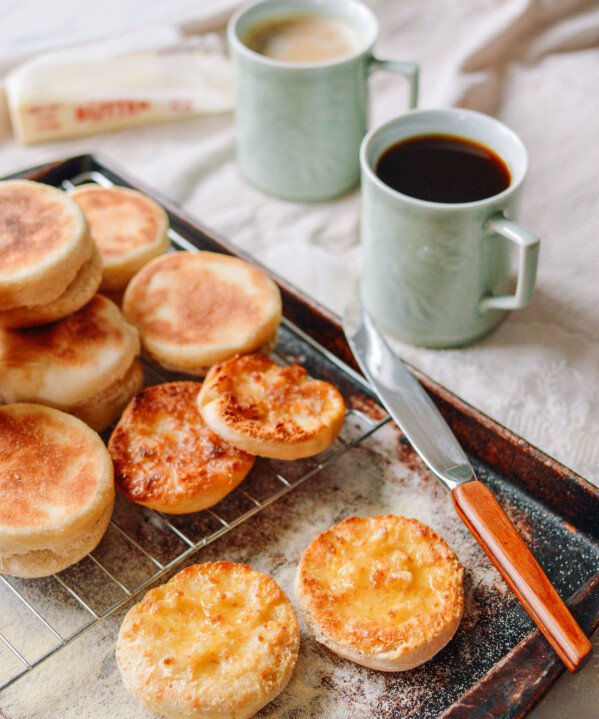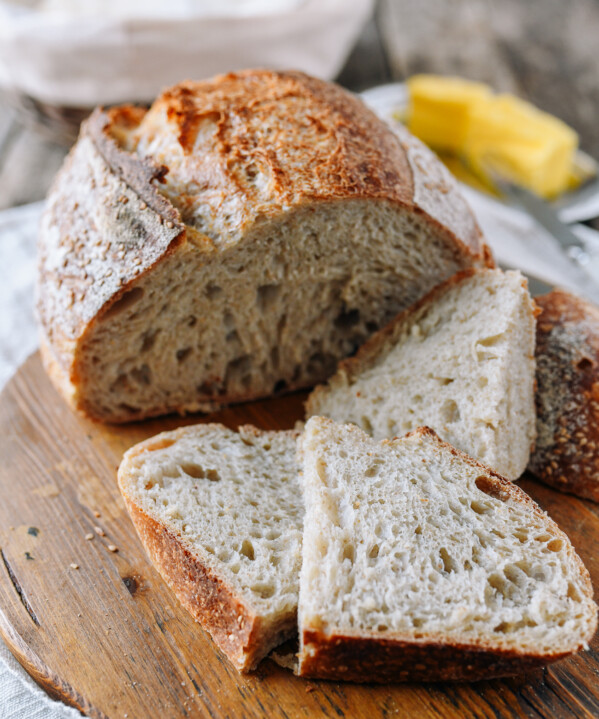These sourdough english muffins are fluffy, flavorful, and freezer-friendly. The nooks and crannies are tops. The crunch factor is THERE.
The dough ferments overnight, so assemble the dough the night before, do one stretch and fold, and let the dough sit on the counter. The next morning, just roll, cut, and cook your muffins after one more quick proof. If you’re already baking sourdough at home, this is another great way to put your starter to work!
Our Best Homemade English Muffin Recipe?
We started our journey baking homemade English muffins when we were temporarily living in Beijing. When you’re living in a foreign country, it’s funny the things you miss! I never gave English muffins much thought, but I found myself craving them when I was thousands of miles away from an American grocery store.
Our simple homemade English muffin recipe, which uses active dry yeast, came out of that time. It is still a go-to in our family! Building on that, we’ve also come up with recipes for Pumpkin English Muffins and Multigrain English Muffins.
That said, since my dad cracked the code on sourdough, we’ve all primarily been baking naturally fermented bread. So we adapted our base English muffin recipe to use sourdough starter, and we have to say…they’re the best ones yet!


The slow fermentation process gives them tons of flavor and a super fluffy rise. They toast really well and have a satisfying crunch when you bite into them.


Slather one in butter and jam, and these might just find yourself making english muffins more often than sourdough boules! Of course, these are great for things like breakfast sandwiches and Eggs Benedict, but we also use them for English muffin pizzas and as rolls for sandwiches/burgers.
Like all of our English muffin recipes, they’re freezer friendly, so fork-split them, put them in a freezer bag, and store them away for future meals!
On Making & Maintaining a Sourdough Starter
This recipe starts with 150g of ripe (fed) sourdough starter. If you’re not sure what that means, we recommend you head to this post on how to make sourdough starter. All you need is all-purpose flour, whole wheat flour, water, and about a week’s time. My dad explains everything you need to do to make and maintain your starter.
Of course, the alternative is to find a friend or family member who already has a starter going. Have them give you some of theirs, feed it to bulk it up, and you’ll be ready to go with this recipe!


An Overnight Recipe
Your dough will ferment overnight to really develop its flavor and rise. It doesn’t require much effort from you, as the starter does most of the work.
That said, it does require some thought given to timing. Here’s the ideal timeline with sample times (you can adjust based on your own schedule):
The Day Before:
1pm: Feed your starter and allow it to double in size (NOTE: depending on how weak/active your starter is, you may need more or less time). You’ll need 150g of ripe starter, so you can feed with 75g water, 75g flour (or less if you have excess starter that you want to use up). The starter is ready to use when it has doubled. This process takes around 4-6 hours.
7pm: Mix the dough and rest for 1 hour.
8:15pm: Stretch and fold the dough (don’t worry if you’re unfamiliar with this technique. It’s as easy as it sounds, and we explain in the recipe). Cover the dough, and leave it overnight to ferment (8-12 hours).
The Day Of:
7:00am: Knead the dough and shape your muffins. Allow them to rise for 30-60 minutes.
8:00am: Cook your muffins in a pan.
8:30am: Enjoy your English muffin breakfast!
Sourdough English Muffins: Recipe Instructions
In a medium mixing bowl, mix the sourdough starter, water, and yogurt.


In a large mixing bowl, combine the dry ingredients: the all-purpose flour, whole wheat flour, sugar, salt, and baking powder.

Pour the wet ingredients into the dry ingredients, and mix with a stiff silicone/rubber spatula or wooden spoon until it forms a soft shaggy dough. You can also do this in a stand mixer with the dough hook attachment.


Tip!
As with all things sourdough and baking, we recommend using metric measurements for best results. That said, if you’d rather use US customary measurements, just tap/click on the “US Customary” button below the ingredients in the recipe card below!
Knead with the rubber spatula, floured hands, or the dough hook attachment for 5 minutes. Cover the dough (a loose, clean plastic grocery bag works well), and let it ferment in a warm place (75-80°F/24-26°C) for 1 hour. We put the dough in a closed microwave next to a big mug of just-boiled water.
After 1 hour, stretch and fold the dough: lift the dough vertically, stretching and folding the dough over to the other side. Continue to repeat this lift, stretch, and fold motion 4-5 times, rotating the bowl each time.


Cover the dough with a clean plastic grocery bag, and let it ferment on the counter overnight (as long as the ambient temperature ranges from 65-70°F/18-21°C—any warmer, and you risk it over-proofing) for 8-12 hours.
After 8-12 hours (i.e. the next morning), you MUST work with the dough quickly to prevent it from over-proofing. The dough will be very puffy and full of air. Punch the air out, using a stiff silicone/rubber spatula to fold the dough over onto itself until you have a ball of dough.
Spread the semolina onto a large rimmed sheet pan.

On a lightly floured surface, use a floured rolling pin to roll the dough out to a thickness of about ½- to ¾-inch (depending on how thick you like your English muffins. If using metric, 1.5cm is a good thickness). Cut out circles with a 3-inch (8cm) round cutter, and place on the sheet pan. Re-roll any excess and form more muffins. You should get 12-14 muffins total. Slide the muffins around on the semolina to ensure they don’t stick to the pan.


Once shaped, cover the muffins with a clean towel and proof them at room temperature for 30 minutes to 1 hour, or until they’ve almost doubled in size.

Want More Flexibility to Your Timing? Fun Fact!
If your kitchen is warmer than 70°F/21°C overnight, or you don’t want the pressure of cooking these muffins early in the morning, you can proof your dough in the cooler, more controlled environment of the refrigerator.
Bulk fermentation in the refrigerator helps to reduce variation in ambient temperature and humidity, which gives you more flexibility when it comes to timing. Rather than having to work with the dough first thing in the morning, you can refrigerate it and let it ferment for anywhere from 8 to 24 hours.
Here’s how:
After the first stretch and fold, rest the dough for another hour, then stretch and fold again. Allow the dough to sit out on the counter for 2 hours, then cover and transfer to the fridge for anywhere from 8-24 hours.
Take the dough out of the refrigerator, and let it sit in a warm place (75-80°F/24-26°C) for 3-4 hours, or until the dough gets back up to room temperature. Then proceed with rolling, cutting, proofing, and cooking your English muffins.
Heat a flat pan, griddle, or cast iron skillet over medium heat. Once the pan is hot, use a thin spatula to transfer the muffins (in batches) from the sheet pan onto the skillet. Cook for 12 minutes, 6 minutes on each side, until firm and golden brown. Turn only once.


Repeat with the remaining muffins.
Once cool enough to handle, use a fork to break the muffins apart. This fork method ensures you get nooks and crannies!


Toast your muffin if desired, and enjoy with butter and/or jam!

Sourdough English Muffins

Ingredients
- 150 g ripe (fed) starter (sourdough starter)
- 235 ml lukewarm water
- 160 ml plain yogurt (or sour cream, preferably at room temperature)
- 385 g all purpose flour (plus more for kneading)
- 165 g whole wheat flour
- 6 g sugar
- 6 g salt
- ½ teaspoon baking powder
- 55 g semolina (or fine cornmeal, for sprinkling)
Instructions
- In a medium mixing bowl, mix the sourdough starter, water, and yogurt. In a large mixing bowl, combine the dry ingredients: the all-purpose flour, whole wheat flour, sugar, salt, and baking powder.
- Pour the wet ingredients into the dry ingredients, and mix with a stiff silicone/rubber spatula or wooden spoon until it forms a soft shaggy dough. You can also do this in a stand mixer with the dough hook attachment.
- Knead with the rubber spatula, floured hands, or the dough hook attachment for 5 minutes. Cover the dough (a loose, clean plastic grocery bag works well), and let it ferment in a warm place (75-80°F/24-26°C) for 1 hour. We put the dough in a closed microwave next to a big mug of just-boiled water.
- After 1 hour, stretch and fold the dough: lift the dough vertically, stretching and folding the dough over to the other side. Continue to repeat this lift, stretch, and fold motion 4-5 times, rotating the bowl each time.
- Cover the dough with a clean plastic grocery bag, and let it ferment on the counter overnight (as long as the ambient temperature ranges from 65-70°F/18-21°C—any warmer, and you risk it overproofing) for 8-12 hours.
- After 8-12 hours (i.e. the next morning), you MUST work with the dough quickly to prevent it from overproofing. The dough will be very puffy and full of air. Punch the air out, using a stiff silicone/rubber spatula to fold the dough over onto itself until you have a ball of dough.
- Spread the semolina onto a large rimmed sheet pan. On a lightly floured surface, use a floured rolling pin to roll the dough out to a thickness of about ½- to ¾-inch (depending on how thick you like your English muffins. If using metric, 1.5cm is a good thickness). Cut out circles with a 3-inch (8cm) round cutter, and place on the sheet pan. Re-roll any excess and form more muffins. You should get 12-14 muffins total. Slide the muffins around on the semolina to ensure they don’t stick to the pan.
- Once shaped, cover the muffins with a clean towel and proof them at room temperature for 30 minutes to 1 hour, or until they’ve almost doubled in size.
- Heat a flat pan, griddle, or cast iron skillet over medium heat. Once the pan is hot, use a thin spatula to transfer the muffins (in batches) from the sheet pan onto the skillet. Cook for 12 minutes, 6 minutes on each side, until firm and golden brown. Turn only once. Repeat with the remaining muffins.
- Once cool enough to handle, use a fork to break the muffins apart. This fork method ensures you get nooks and crannies! Toast your muffin if desired, and enjoy with butter and/or jam!




